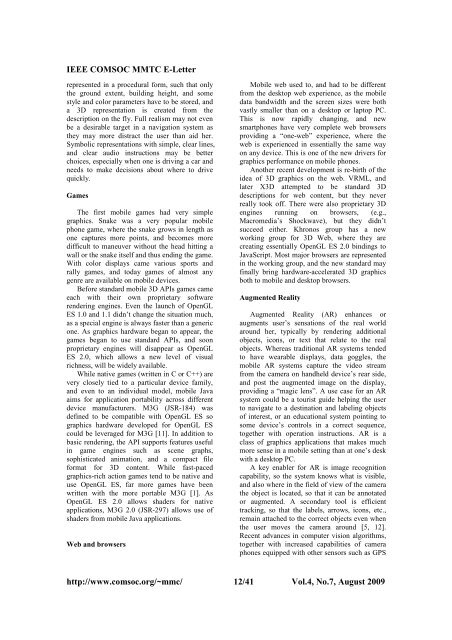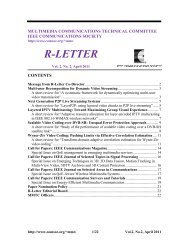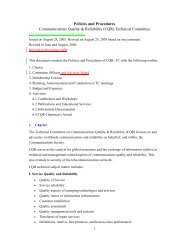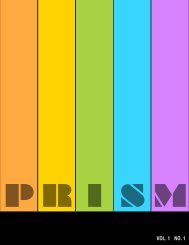E-LETTER - IEEE Communications Society
E-LETTER - IEEE Communications Society
E-LETTER - IEEE Communications Society
You also want an ePaper? Increase the reach of your titles
YUMPU automatically turns print PDFs into web optimized ePapers that Google loves.
<strong>IEEE</strong> COMSOC MMTC E-Letterrepresented in a procedural form, such that onlythe ground extent, building height, and somestyle and color parameters have to be stored, anda 3D representation is created from thedescription on the fly. Full realism may not evenbe a desirable target in a navigation system asthey may more distract the user than aid her.Symbolic representations with simple, clear lines,and clear audio instructions may be betterchoices, especially when one is driving a car andneeds to make decisions about where to drivequickly.GamesThe first mobile games had very simplegraphics. Snake was a very popular mobilephone game, where the snake grows in length asone captures more points, and becomes moredifficult to maneuver without the head hitting awall or the snake itself and thus ending the game.With color displays came various sports andrally games, and today games of almost anygenre are available on mobile devices.Before standard mobile 3D APIs games cameeach with their own proprietary softwarerendering engines. Even the launch of OpenGLES 1.0 and 1.1 didn’t change the situation much,as a special engine is always faster than a genericone. As graphics hardware began to appear, thegames began to use standard APIs, and soonproprietary engines will disappear as OpenGLES 2.0, which allows a new level of visualrichness, will be widely available.While native games (written in C or C++) arevery closely tied to a particular device family,and even to an individual model, mobile Javaaims for application portability across differentdevice manufacturers. M3G (JSR-184) wasdefined to be compatible with OpenGL ES sographics hardware developed for OpenGL EScould be leveraged for M3G [11]. In addition tobasic rendering, the API supports features usefulin game engines such as scene graphs,sophisticated animation, and a compact fileformat for 3D content. While fast-pacedgraphics-rich action games tend to be native anduse OpenGL ES, far more games have beenwritten with the more portable M3G [1]. AsOpenGL ES 2.0 allows shaders for nativeapplications, M3G 2.0 (JSR-297) allows use ofshaders from mobile Java applications.Web and browsersMobile web used to, and had to be differentfrom the desktop web experience, as the mobiledata bandwidth and the screen sizes were bothvastly smaller than on a desktop or laptop PC.This is now rapidly changing, and newsmartphones have very complete web browsersproviding a “one-web” experience, where theweb is experienced in essentially the same wayon any device. This is one of the new drivers forgraphics performance on mobile phones.Another recent development is re-birth of theidea of 3D graphics on the web. VRML, andlater X3D attempted to be standard 3Ddescriptions for web content, but they neverreally took off. There were also proprietary 3Dengines running on browsers, (e.g.,Macromedia’s Shockwave), but they didn’tsucceed either. Khronos group has a newworking group for 3D Web, where they arecreating essentially OpenGL ES 2.0 bindings toJavaScript. Most major browsers are representedin the working group, and the new standard mayfinally bring hardware-accelerated 3D graphicsboth to mobile and desktop browsers.Augmented RealityAugmented Reality (AR) enhances oraugments user’s sensations of the real worldaround her, typically by rendering additionalobjects, icons, or text that relate to the realobjects. Whereas traditional AR systems tendedto have wearable displays, data goggles, themobile AR systems capture the video streamfrom the camera on handheld device’s rear side,and post the augmented image on the display,providing a “magic lens”. A use case for an ARsystem could be a tourist guide helping the userto navigate to a destination and labeling objectsof interest, or an educational system pointing tosome device’s controls in a correct sequence,together with operation instructions. AR is aclass of graphics applications that makes muchmore sense in a mobile setting than at one’s deskwith a desktop PC.A key enabler for AR is image recognitioncapability, so the system knows what is visible,and also where in the field of view of the camerathe object is located, so that it can be annotatedor augmented. A secondary tool is efficienttracking, so that the labels, arrows, icons, etc.,remain attached to the correct objects even whenthe user moves the camera around [5, 12].Recent advances in computer vision algorithms,together with increased capabilities of cameraphones equipped with other sensors such as GPShttp://www.comsoc.org/~mmc/ 12/41 Vol.4, No.7, August 2009
















